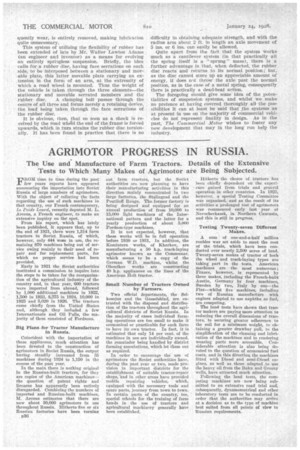AGRIMOTOR PROGRESS IN RUSSIA.
Page 54

If you've noticed an error in this article please click here to report it so we can fix it.
The Use and Manufacture of Farm Tractors. Details of the Extensive Tests to Which Many Makes of Agrimotor are Being Subjected.
FROM time to time during the past few years reports have appeared announcing the importation into Soviet Russia of large numbers of agrimotors. With the object of collating the facts regarding the use of such machines in that country, our French contemporary, Le Poids Lowayl, recently deputed NI. L. Among, a French engineer, to make an extensive inquiry on the spot.
From his report, which has lately been published, it appears that, up to the end of 1921, there were 1,314 farm tractors in Soviet Russia, of which, however, only 444 wove in use, the remaiaing 870 machines being out of service owing mainly to their need of repair and for replacement parts, for which no proper service had been provided.
Early in 1921 the Soviet authorities instituted a commission to inquire into the steps to be taken for the reorganization of the agricultural industry of the country and, in that year, 600 tractors were imported from abroad, followed by 1,000 additional machines in 1922, 1,500 in 1923, 8,375 in 1924, 10,000 in 1925 and 5,020 in 1926. The tractors came chiefly from the United States and, although they included a few Internationals and Oil Pulls, the majority of them consisted of Fordsons.
Big Plans for Tractor Manufacture in Russia.
Coincident with the importation of these appliances, much attention has been devoted to the construction of agrimotors in Soviet Russia, the output having steadily increased from 35 machines during 1924 to 1,150 in the course of the past year.
In the main there is nothing original in the Russian-built tractors, for they are copies of the American machines* question of patent rights and licences has apparently beenti 1 en, .re.y disregarded. Combining the numbers of imported and Russian-built machines. 31. Arcous estimates that there are now about 30,000 agrimotors in use throughout Russia. hitherto five or six Russian factories have been turning
536
out farm tractors, but the Soviet authorities are now planning to have their manufacturing activities in this direction mainly concentrated in two large factories, the Stalingrad and the routiloff Rouge. The former factory is being designed and equipped for an annual production of from 10,000 to 15,001) light machines of the International pattern and the latter for a yearly production of about 5,000 Fordson-type machines.
It is not expected, however, that these works will be in full operation before 1930 or 1931. In addition, the "Comintern works, of Kharkov, are manufacturing a 50 hp. track-laying agrimotor known as the Communar, which seema to be a copy of the German W.D. machine, whilst the Ohouthov works are constructing 40 h.p. appliance on the lines of the American holt tractor.
Small Number of Tractors Owned by Farmers.
Two official departments, the Selkosojuz and the Gosselsklad, are entrusted with the disposal and distribution of the tractors throughout the agricultural districts of Soviet Russia. In the majority of cases individual farming operations are too small to make it economical or practicable for each farm to have its own tractor. In fact, it is estimated that only 14 per cent, of the machines in use are individually owned, the remainder being handled by district farming associations, which let them out as required.
In order to encourage the use of agrimotors the Soviet authorities have, during the past year or two, made provision in important districts for the establishment of suitable tractor-repair shops, -and in other areas have provided mobile repairing vehicles; which, equipped with the necessary tools and spare parts, journey from town to town. In certain parts of the country, too, special schools for the training of farm hands in the use of tractors and agricultural machinery generally have been established. hitherto the choice of tractors has been chieflydependent on the experience gained from trials and general operation in other countries. In 1925, however, a special Testing Committee was organized, and as the result of its activities a prolonged test of agrimotors was commenced early last year at Novocherkassk,. in Northern Caucasia, and this is still in progress, Testing Twenty-seven Different Makes.
A sum of one-and-a-half million roubles was set aside to. meet the cost Of the trials, which have been conducted over nearly 2,500 acres of land. Twenty-seven makes of tractor of both the wheel and track-laying types are taking part in the tests. American machines are the most numerous ; France, however, is represented by three makes, including the French-buiit Austin, Germany by four, machines, Sweden by two, Italy by one—the Fiat—whilst five machines, including two of Russian manufacture with engines adapted to use naphtha as fuel, are competing.
The land tests have shown that tractor makers are paying more attention to reducing the overall dimensions of tractors; to securing greater adherence to the soil for a minimum weight, to obtaining a greater drawbar pull, to the simplification of the cleaning and hibriCation of the machines and to rendering wearing parts more accessible. Considerable attention is also being devoted to the question of economical fuel costs, and in this direction the machines fitted with Diesel and semi-Diesel englues, as well as those adapted to use the heavy oil from the Baku and Grosny wells, have attracted much attention.
Following the land tests, the competing machines are now being submitted to an extensive road trial and, subsequently, dynamometrical and other laboratory tests are to be conducted in order that the authorities may arrive at a decision as to the type of machine best suited from all points of view to Russian requirements.




































































































